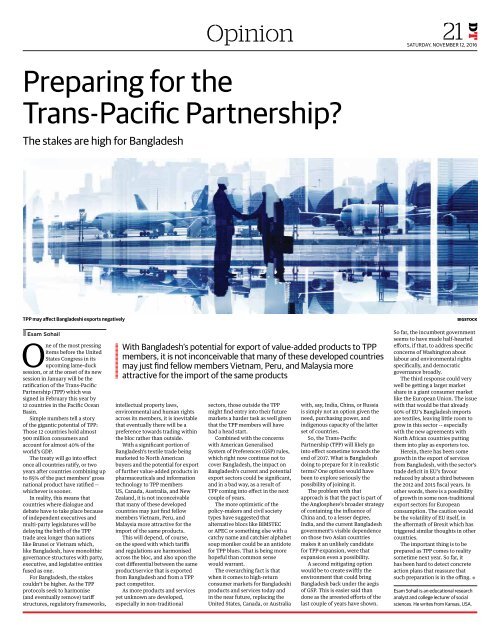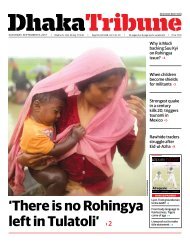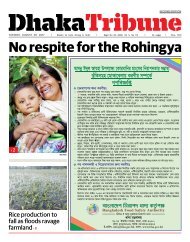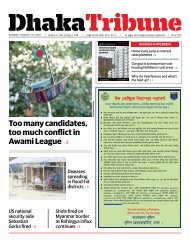DT e-Paper, Saturday, 12 November, 2016
Create successful ePaper yourself
Turn your PDF publications into a flip-book with our unique Google optimized e-Paper software.
Opinion 21<br />
Preparing for the<br />
Trans-Pacific Partnership?<br />
The stakes are high for Bangladesh<br />
<strong>DT</strong><br />
SATURDAY, NOVEMBER <strong>12</strong>, <strong>2016</strong><br />
TPP may affect Bangladeshi exports negatively<br />
BIGSTOCK<br />
• Esam Sohail<br />
One of the most pressing<br />
items before the United<br />
States Congress in its<br />
upcoming lame-duck<br />
session, or at the onset of its new<br />
session in January will be the<br />
ratification of the Trans-Pacific<br />
Partnership (TPP) which was<br />
signed in February this year by<br />
<strong>12</strong> countries in the Pacific Ocean<br />
Basin.<br />
Simple numbers tell a story<br />
of the gigantic potential of TPP:<br />
Those <strong>12</strong> countries hold almost<br />
900 million consumers and<br />
account for almost 40% of the<br />
world’s GDP.<br />
The treaty will go into effect<br />
once all countries ratify, or two<br />
years after countries combining up<br />
to 85% of the pact members’ gross<br />
national product have ratified --<br />
whichever is sooner.<br />
In reality, this means that<br />
countries where dialogue and<br />
debate have to take place because<br />
of independent executives and<br />
multi-party legislatures will be<br />
delaying the birth of the TPP<br />
trade area longer than nations<br />
like Brunei or Vietnam which,<br />
like Bangladesh, have monolithic<br />
governance structures with party,<br />
executive, and legislative entities<br />
fused as one.<br />
For Bangladesh, the stakes<br />
couldn’t be higher. As the TPP<br />
protocols seek to harmonise<br />
(and eventually remove) tariff<br />
structures, regulatory frameworks,<br />
With Bangladesh’s potential for export of value-added products to TPP<br />
members, it is not inconceivable that many of these developed countries<br />
may just find fellow members Vietnam, Peru, and Malaysia more<br />
attractive for the import of the same products<br />
intellectual property laws,<br />
environmental and human rights<br />
across its members, it is inevitable<br />
that eventually there will be a<br />
preference towards trading within<br />
the bloc rather than outside.<br />
With a significant portion of<br />
Bangladesh’s textile trade being<br />
marketed to North American<br />
buyers and the potential for export<br />
of further value-added products in<br />
pharmaceuticals and information<br />
technology to TPP members<br />
US, Canada, Australia, and New<br />
Zealand, it is not inconceivable<br />
that many of these developed<br />
countries may just find fellow<br />
members Vietnam, Peru, and<br />
Malaysia more attractive for the<br />
import of the same products.<br />
This will depend, of course,<br />
on the speed with which tariffs<br />
and regulations are harmonised<br />
across the bloc, and also upon the<br />
cost differential between the same<br />
product/service that is exported<br />
from Bangladesh and from a TPP<br />
pact competitor.<br />
As more products and services<br />
yet unknown are developed,<br />
especially in non-traditional<br />
sectors, those outside the TPP<br />
might find entry into their future<br />
markets a harder task as well given<br />
that the TPP members will have<br />
had a head start.<br />
Combined with the concerns<br />
with American Generalised<br />
System of Preferences (GSP) rules,<br />
which right now continue not to<br />
cover Bangladesh, the impact on<br />
Bangladesh’s current and potential<br />
export sectors could be significant,<br />
and in a bad way, as a result of<br />
TPP coming into effect in the next<br />
couple of years.<br />
The more optimistic of the<br />
policy-makers and civil society<br />
types have suggested that<br />
alternative blocs like BIMSTEC<br />
or APEC or something else with a<br />
catchy name and catchier alphabet<br />
soup moniker could be an antidote<br />
for TPP blues. That is being more<br />
hopeful than common sense<br />
would warrant.<br />
The overarching fact is that<br />
when it comes to high-return<br />
consumer markets for Bangladeshi<br />
products and services today and<br />
in the near future, replacing the<br />
United States, Canada, or Australia<br />
with, say, India, China, or Russia<br />
is simply not an option given the<br />
need, purchasing power, and<br />
indigenous capacity of the latter<br />
set of countries.<br />
So, the Trans-Pacific<br />
Partnership (TPP) will likely go<br />
into effect sometime towards the<br />
end of 2017. What is Bangladesh<br />
doing to prepare for it in realistic<br />
terms? One option would have<br />
been to explore seriously the<br />
possibility of joining it.<br />
The problem with that<br />
approach is that the pact is part of<br />
the Anglosphere’s broader strategy<br />
of containing the influence of<br />
China and, to a lesser degree,<br />
India, and the current Bangladesh<br />
government’s visible dependence<br />
on those two Asian countries<br />
makes it an unlikely candidate<br />
for TPP expansion, were that<br />
expansion even a possibility.<br />
A second mitigating option<br />
would be to create swiftly the<br />
environment that could bring<br />
Bangladesh back under the aegis<br />
of GSP. This is easier said than<br />
done as the arrested efforts of the<br />
last couple of years have shown.<br />
So far, the incumbent government<br />
seems to have made half-hearted<br />
efforts, if that, to address specific<br />
concerns of Washington about<br />
labour and environmental rights<br />
specifically, and democratic<br />
governance broadly.<br />
The third response could very<br />
well be getting a larger market<br />
share in a giant consumer market<br />
like the European Union. The issue<br />
with that would be that already<br />
90% of EU’s Bangladesh imports<br />
are textiles, leaving little room to<br />
grow in this sector -- especially<br />
with the new agreements with<br />
North African countries putting<br />
them into play as exporters too.<br />
Herein, there has been some<br />
growth in the export of services<br />
from Bangladesh, with the sector’s<br />
trade deficit in EU’s favour<br />
reduced by about a third between<br />
the 20<strong>12</strong> and 2015 fiscal years. In<br />
other words, there is a possibility<br />
of growth in some non-traditional<br />
export sectors for European<br />
consumption. The caution would<br />
be the volatility of EU itself, in<br />
the aftermath of Brexit which has<br />
triggered similar thoughts in other<br />
countries.<br />
The important thing is to be<br />
prepared as TPP comes to reality<br />
sometime next year. So far, it<br />
has been hard to detect concrete<br />
action plans that reassure that<br />
such preparation is in the offing. •<br />
Esam Sohail is an educational research<br />
analyst and college lecturer of social<br />
sciences. He writes from Kansas, USA.


















